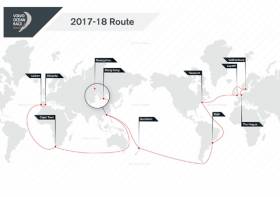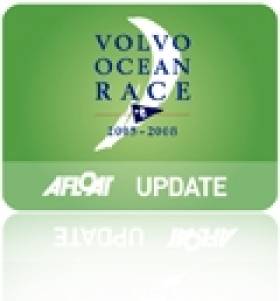Displaying items by tag: Southern Ocean
The Ocean Race Course Updated With Epic Southern Ocean Leg
The next edition of The Ocean Race will feature the longest Southern Ocean leg in the 50 year history of the event, an incredible 12,750 nautical mile marathon between Cape Town, South Africa to Itajaí, Brazil.
This is just one of the highlights of the updated race course confirmed, which will not include a Pacific leg via New Zealand or China.
The race route for the 14th edition of the event has been designed in response to the logistical realities of an around-the-world race in a COVID-19 environment and will start from Alicante, Spain in late December 2022 or early January 2023, with the final date to be announced.
From there, the IMOCA and VO65 fleets will sprint out of the Mediterranean Sea to Cabo Verde, visiting this African island nation for the very first time, before racing down to a perennial favourite among stopovers in Cape Town.
Then, a return to the roots of the race — with a massive sojourn through the Southern Ocean, over 30 days of racing, to Itajaí, host of the past three stopovers in South America.
This will be the longest leg in the history of The Ocean Race, dating all the way back to the very first fully crewed around-the-world race in 1973.
‘We believe the 12,750 nautical mile leg from Cape Town to Itajaí is a very special element — unique in history — in the next race’
And it will also see a transit of the three great capes — the Cape of Good Hope, Cape Leeuwin and Cape Horn — in succession, without a stopover, for the very first time.
“We believe the 12,750 nautical mile leg from Cape Town to Itajaí is a very special element — unique in history — in the next race,” said Johan Salén, managing director of The Ocean Race.
“The ongoing and unpredictable effects of COVID have meant it is impossible, at this time, to do the planning necessary to ensure successful stops in China and New Zealand.”
Race chair Richard Brisius added: “China and New Zealand remain important to the present and the future of The Ocean Race, and we plan to return to both countries again. We will work diligently with both to explore ways for them to have a meaningful presence in this edition as well.
“China, of course, has a strong history of hosting stopovers since 2008-09 and was the winner of the last edition of the race, with the Dongfeng Race Team.
“And we consider Auckland to be a spiritual home for this event, with legends like Sir Peter Blake, Grant Dalton, Ross Field and Mike Sanderson, to name just a few among so many of the amazing Kiwis who have taken on this challenge. Their legacy is woven into the fabric of The Ocean Race.”
Following the Southern Ocean leg, and after rounding the famed Cape Horn, teams will stop in Itajaí to recharge bodies and boats. Then the race course will take in Newport in Rhode Island, USA before crossing the Atlantic to northern European stops in Aarhus, Denmark and The Hague in The Netherlands, before the Grand Finale finish in the Mediterranean at Genoa, Italy.
‘Not only is it a simpler race from a logistics and organisation point of view, it should also be more cost-effective and more accessible’
“This update to the race route makes it reminiscent of the original Ocean Races of the past, and I hope the delay of the start until after the Route du Rhum will entice more teams to join us on the start line,” said Charlie Enright, skipper of 11th Hour Racing Team.
“Not only is it a simpler race from a logistics and organisation point of view, it should also be more cost-effective and more accessible for other IMOCA teams, particularly those looking to build-up to the 2024 Vendée Globe.
“The confirmed course is exciting - one month at sea, racing through the Southern Ocean, on the longest leg we’ve ever faced. It’s a reminder that we will need to be at the top of our game to take it on, and allows us to really hone in on our preparations, starting with the Transat Jacques Vabre this weekend.”
Stopover dates will be announced shortly as the route logistics are fully confirmed.
“These are challenging but nonetheless very exciting times for international events like The Ocean Race,” Brisius said. “We have a clear mission ahead — to enable our sailors to achieve the extraordinary, while driving change towards a healthier, sustainable planet.
“Following on from the inaugural edition of The Ocean Race Europe this spring, the 14th edition of the around-the-world race is the next phase in our 10-year plan of events, which includes regional and global races, as well as our series of The Ocean Race Summits, designed to explore solutions and drive meaningful change towards the restoration of ocean health.
“We will continue working with all of our stakeholders: teams, host cities, partners, race fans and media to make progress on these goals.”
Entries for the race will be announced by participating teams over the coming months.
“This race course, for sailors and teams in both the IMOCA and VO65 classes, is shaping up to provide one of the toughest challenges in the long story of the Race,” Salén said.
“Over our 50 years of history, The Ocean Race has evolved with the times, but remained true to its core values. We’re looking forward to the next start in Alicante in December/January to write the next chapter.”
Volvo Ocean Race Returns To Southern Ocean Roots
#VOR - The next edition of the Volvo Ocean Race will be contested over the longest distance in race history at around 45,000 nautical miles,
Crossing four oceans and taking in 11 major cities on five continents, the 2017-18 race will also feature nearly three times as much Southern Ocean sailing as the previous edition, marking a return to its roots.
The VOR fleet will start from Alicante in late 2017 with a 700nm sprint to Lisbon that will provide the first test of the form guide.
From the Portuguese capital, the fleet will plunge south towards Cape Town in South Africa, before an epic few weeks racing through the Southern Ocean and then back north across the equator to Hong Kong in what promises be one of the longest legs in VOR history.
After a non-scoring transition to Guangzhou, China, where an in-port race and full set of stopover activities will be held, the ocean racing will resume from Hong Kong to Auckland, New Zealand.
The fleet will then head back through the Southern Ocean, around the most famous landmark of them all, Cape Horn, and up through the Atlantic Ocean to the southern Brazilian city of Itajaí.
From there, as in the last edition, the boats will head back in to the northern hemisphere to the Eastern Seaboard of the USA and Newport, Rhode Island before a blast across the North Atlantic on the blue riband transatlantic leg, which will see them make a first return to British shores in 12 years.
The fleet will arrive in Cardiff, capital city of Wales, in May 2018 before beating its way around the top of the British Isles on a short but potentially brutal leg to the penultimate stopover in Gothenburg, Sweden.
The 2017-18 race will end with a grand finale into The Hague in the Netherlands.
The total distance of the racetrack is longer than in any of the 12 previous editions of an event which was born as the Whitbread Round the World Race in 1973.
But while the teams will sail more nautical miles than ever before, the race itself is scheduled to be one month shorter than in most of the last 12 editions.
“More action, more speed, more tough miles and more host venues, but a shorter race – it’s an evolution in the right direction and a move that takes the race closer to its original roots and heritage, while improving its strong commercial value and excellent business case for sponsors,” said Mark Turner, who took over as CEO of the Volvo Ocean Race earlier this month.
Around 12,500nm of the race will take place in the Southern Ocean, the fast-moving, ice cold waters around the Antarctic where, unhindered by land, some of the deepest weather depressions circle the bottom of the global, generating giant waves and punishing, heavy winds that can peak at over 70 knots (130 km/h).
In the previous edition, the teams spent around 4,500nm racing in the Southern Ocean.
“In 2017-18 we’ll be visiting some of the world’s most famous sailing cities – places like Cape Town, Auckland and Newport, Rhode Island – while also taking the Race to fresh audiences in new cities,” said Turner as the route was unveiled today (Wednesday 29 June).
“Firstly to Hong Kong, an incredible city, which will act as a hub for south-east Asian fans and VIP guests. Then on to Guangzhou, China – the first time the race will visit one of just four premium Tier 1 cities in the country.
“And finally to Cardiff, taking the Race back to the UK for the first time since 2005-06. The United Kingdom is the birthplace of The Whitbread Round the World Race, which had its first start from Portsmouth in 1973 and later became the Volvo Ocean Race in 1998.”
Looking forward, Turner added: “It’s also great to be preparing for a fourth consecutive start from our home port of Alicante, and heading back to familiar cities where we’re building a legacy for the Race – to Lisbon, Itajaí, Gothenburg and The Hague.”
Race operations director Richard Mason also commented: “In the last edition we welcomed over 2.4 million visitors and over 70,000 corporate guests to our host city venues.
"We’re determined to offer even more exciting sailing in 2017-18, while making the race village experience even better for our fans, guests and partners.”
Mason, himself a five-time Volvo Ocean Race sailor, added: “I’m pretty tempted to return to the sailing now I’ve seen this amazing new route, but my new CEO has banned me!”
The Southern Ocean has played an huge role in the history of the Volvo Ocean Race. In the early years of the Whitbread, the fleet would head as deep into the Southern Ocean as possible, braving the icebergs and ferocious winds of the Roaring Forties and Furious Fifties in order to shave as much distance off the route as they could.
In more recent editions, the boats have raced north through the Indian Ocean, towards the Middle East – and have only returned to the south and its more extreme weather for the shorter leg across to Cape Horn.
“Of course, safety remains paramount,” said Phil Lawrence, incoming race director. “With state-of-the-art tracking systems and satellite communication, alongside access to in-depth route information, we can stay one step ahead of the conditions and limit the exposure of the sailors.
“But ultimately, there will always be danger. Sailors know they put their lives on the line when they take on ‘the Everest’ of professional sailing. That’s what the Volvo Ocean Race is all about – taking the toughest conditions that Mother Nature can throw at you, and overcoming them.”
Dongfeng VOR Leaders Bow Out of Southern Ocean
#vor – Dongfeng Race Team with Ireland's Damian Foxall onboard announced late last night that they plan to retire from Leg 5 of the Volvo Ocean Race after breaking their mast in the Southern Ocean. Skipper Charles Caudrelier had considered attempting to re-join the 6,776-nautical mile stage from Auckland to Itajaí after successfully nursing Dongfeng to Ushuaia, Argentina, earlier in the day.
But on Tuesday night, a statement from the team read: "The decision has been made to motor-sail to Itajaí and not rejoin the race – although skipper Caudrelier has yet to officially retire from the leg at this time, it is just a matter of protocol now.
"He will not relish this part of the administrative process and if there had been any other timely and effective way to rejoin the race and get to Brazil, he would have undoubtedly taken it.
"But even under motor-sail the delivery trip is expected to take around 10-12 days and then add the days needed to refit the boat in time for the start of Leg 6 to Newport.
"Trying to rejoin the race which would mean returning to the point they started using the engine at the western entrance of the (Beagle) Channel then sail south around Cape Horn would prove to be too risky, especially with rig and sails not fully fit for racing.
"It wasn't safe to enter the Beagle Channel without the engine, even if it would have left more options for a racing departure."
By motoring to Itajaí, they will buy some time to make the repairs ready to start Leg 6 to Newport - although it will still be tight. The fleet is due to depart on April 19.
Dongfeng Race Team plan to leave Ushuaia for Itajaí on Wednesday evening.
At 0315 on Monday, a sickening crack had signaled to Caudrelier and his crew that the top section of the mast had fractured, leaving the boat without full manoueverability.
The decision means that Dongfeng Race Team, who were joint leaders with Abu Dhabi Ocean Racing (Ian Walker/GBR) at the start of the leg, will collect eight points for a Did Not Finish result.
In the latest position report at 1840 UTC on Tuesday, Abu Dhabi Ocean Racing led by 8.8nm from Cape Horn pace-setters, Team Alvimedica (Charlie Enright/USA)
For Irish Offshore Racing Sailors, 'Tis The Season To Be Sailing To Hobart
#rshyr – Tasmania is a medium-sized island in the Great Southern Ocean which is sheltered to the west only by South America. And as Tasmanians reckon skinny little New Zealand doesn't really provide a proper lee, they'll tell you their island is also sheltered to the east only by South America. So although it is at the same latitude in the south as Bordeaux in southern France is in the north, Tasmania's weather conditions – particularly the winds – can be much more extreme than they are in Bordeaux.
For sure, this lovely island can have some beautiful summer weather. But equally, it can serve up some very demanding sailing conditions. Thus the annual 628-mile Rolex Sydney-Hobart Race inevitably brings the fleet into increasingly hostile seas the further south they progress down much of the course. And the Bass Strait between Australia and Tasmania is a notoriously rough bit of water which has claimed lives in this event.
But then the twist in the tail is the final ten or so miles from the Iron Pot up the narrowing and increasingly flukey Derwent Estuary to the finish at the Hobart waterfront. This concluding crawl can test any sailor's sportsmanship as he or she sees a good position, hard earned over hours and days on a very rough sea, wafted away in calm spots and fickle zephyrs. Indeed, some hardened Hobart race veterans reckon the real contest finishes not even at the Iron Pot, but rather as you enter Storm Bay in the approaches to the Derwent Estuary, saying that it's just a lottery thereafter. But despite such criticisms, the race is one of sailing's great events. W M Nixon takes a look at this year's 70th staging of the classic, which starts in traditional style on Sydney Harbour in less than six days time.
If the annual Rolex Sydney-Hobart Race didn't exist, then world sailing would have to invent it. But happily, it's there already for our absorption and enjoyment. And in 2014 for its 70th staging, it's more relevant than ever in an era of instant global communication. When we remember that much more than half of humanity lives in the Northern Hemisphere and many of them are now in the depths of winter, the fact that there's this glorious and accessible sailing spectacle all ready to roll on screens worldwide, just as we're finally sated with Christmas and all its trappings, is a sanity-preserver for anyone interested in boats and sport.
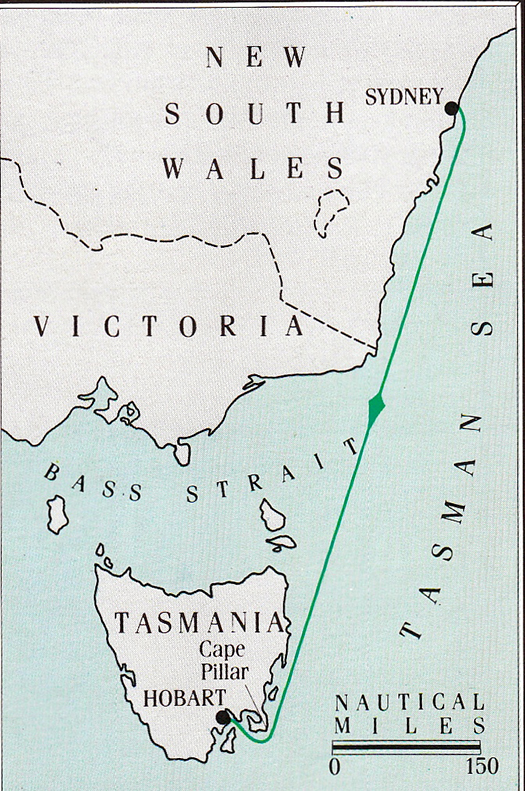
The great race's 628 mile course takes the competitors ever deeper towards the Southern Ocean with every mile sailed.
Of course there's Irish involvement in it at a specific level, with two boats in particular carrying our special interest. But at a more generous level, anyone who has the slightest interest in sailing cannot but be fired up by the wonder of an event in which some of the most advanced hundred footers in the world are swept up in a contest in which they will not only be in cut-throat competition with each other for line honours, but at the end, when all the calculations have been done, for dyed-in-the-wool offshore racing enthusiasts the real competition will be for the Tattersall's Cup, the hugely prestigious trophy for the overall handicap winner.
With 117 expected starters of all sizes from 33ft to 100ft, as the race gets under way each boat will have its own ideal set of conditions and circumstances to suit crew hopes. But as the contest continues, there'll be those who start to emerge in the leading group on handicap, and by the time they're in the final approaches, it is usually whittled down to about a dozen boats or even less which are in there with a shout for the Tattersall's.
But the line honours race for the Illingworth Cup – named in honour of the great British offshore racing skipper and innovator John Illingworth who first suggested the race in 1945 and won it too – now that's a different animal altogether. It's a real death or glory battle. And there's something specially entertaining and attractive about a no-holds-barred contest between boats you could like a lot, just at the time when the word is that the current flotilla of Volvo Round the World Racers may not be very likeable boats at all.
For we hear that the Volvo 65s are twitchy beasts, and not really fun to sail. To have a boat which turns round and looks at you is unfortunate. To have a boat which lies on its back and waves its legs in the air is unfortunate. But a boat that does both....? Oscar Wilde's Lady Bracknell said everything about such a situation.
So we'll return with relief to the crazy guys with the glorious big boats at the front of the fleet in the race to Hobart, for after the Volvo 65s, they're like a breath of fresh air. This is definitely not the territory of careful accountants and penny-pinching save-a-dime boatbuilding. We're looking at the stuff of legend. And the people's favourite has to be the veteran Wild Oats XI, marvellously campaigned by Mark Richards and his team of all the talents with the full support of the veteran owner Bob Oatley (86), whose wine brand of Wild Oats – one of many business interests – doesn't suffer any image problems at all when his boat of the same name wins yet again.
They talk of the Reichel Pugh designed super-slim Wild Oats XI as a "beloved old boat", but in truth she has been so continuously modified that you'd be hard put to say just what is original. The word is they've made her waterlines even narrower up forward – she used to be skinny, but now she's anorexic. As for last year's secret ingredient, the horizontal hydrofoil which, when deployed to lee, reportedly improved performance by up to 4% by making the boat better able to carry sail, for this year's race they tried making it even longer, such that it didn't entirely retract into the housing. But it seems that with a bit sticking out permanently on the weather side, it created more fuss than it was worth, so it has been shortened back to disappear entirely when not in use.
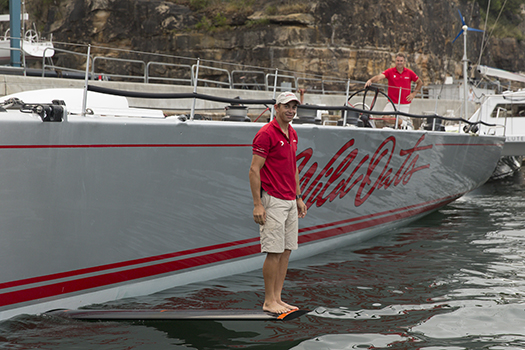
Wild Oats XI has so many bits and pieces sticking out of her hull that she has been compared to a Swiss Army Knife. This is skipper Mark Richards standing on the horizontal hydrofoil which, when deployed on the lee side, gives sufficient lift to significantly improve sail-carrying power. However, it has been shown that it has to be completely retractable into its housing when on the weather side, otherwise it causes unacceptable turbulence.
This conclusion on the downside of making the hydrofoil even longer emerged from some serious heavy weather sailing by Wild Oats off Sydney recently, when she was getting her final pre-Hobart race test and crew training. Heading back to port, with only about a quarter of the mainsail set in a very big wind, the silver arrow was making up to 33 knots. That will be food for thought for the four other hundred footers, the most challenging of which is of course Jim and Kristy Hinze Clark's new Comanche, just out of the wrappings, a hundred foot of total racer with Kenny Read as skipper.
The new girl on the block. American Jim Clark and his Australian wife Kristy Hinze Clark will debut their new hundred footer Comanche in the Rolex Sydney-Hobart 2014.
The same Kenny Read endeared himself to the Irish sailing community during the first Volvo visit to Galway five years ago, when he exited the dock somehow managing to look cool wearing a Paddy Hat that no-one else would be seen dead in. The boy is still busy, as he's worldwide president of North Sails, while his current main commitment afloat is to campaign the very extreme Comanche to the limit, with the Rolex-Sydney Hobart Race 2014 the first outing for real.

God be with the days.....five years ago, Kenny Read endeared himself to the people of Ireland by managing to look cool in this hat while exiting Galway Docks during the Volvo stopover. Photo: Failte Ireland/David Branigan
The hundred footers did have their first encounter a couple of weeks ago with the CYCA Solas Big Boat Challenge in Sydney Harbour, but racing boats this size in such relatively restricted water gives a somewhat skewed picture. Nevertheless the very experienced tacticians on Wild Oats still managed to finish first, as they did last year, but it was Comanche second quite a bit clear of Anthony Bell's Perpetual Loyal.
Once upon a time, Perpetual Loyal was very well known in Ireland, but that was in 2011 when she was George David's Rambler 100, and upside-down off West Cork. Until Comanche's appearance, Perpetual Loyal was reckoned the potentially fastest hundred footer of them all if she just could get enough wind in the right direction. But now the hundred footer field is wide open as a number of them have been undergoing major modifications of the kind you might expect to see on model yachts, but not on thirty metre hulls.

Can you see the join? The entire aft half of Rio 100 is entirely new, thanks to several months of major surgery in Auckland.
Thus the former Lahana, now American-registered, owned by Manouch Moshayedi and re-named Rio 100, simply had her entre aft half cut off, and replaced with a new wider stern section. Just like that. But you ain't heard nuthin' yet. The irrepressible Syd Fischer, shaping up to do his 50th Sydney-Hobart at the age of 87, decided that the hull of his hundred foot Ragamuffin needed some mods. A lot of mods. So he has just kept the deck and rig, but cut off the original hull, and replaced it with a new one from the same designer, Andy Dovell.
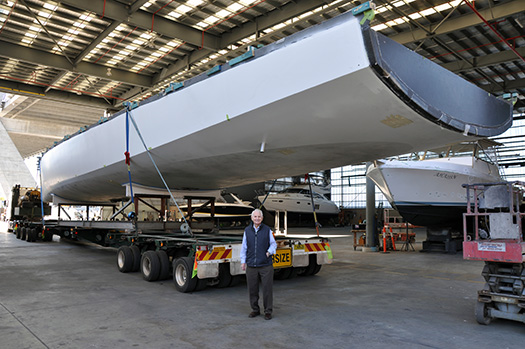
The incredible Syd Fischer, a sprightly 87-years-old, with the entirely new Andy Dovell-designed hull before it was fitted under the deck and rig of his previous hundred footer Ragamuffin.
So if next time you're on Sydney Harbour and a peculiar-looking hundred foot motorboat comes tootling past with a slightly lost air to her, you'll know why. She could swear that once upon a time she had a deep keel and a great big mast. But she's out and motoring about because there's no way Australians will let a redundant hundred foot hull go to waste. Meanwhile, the new raceboat hull has barely had time for testing, but we're assured all will be well, and the something old, something new Ragamuffin 100 will be there on the line raring to go against Wild Oats, Comanche, Perpetual Loyal and Rio 100 in the battle for line honours.
But as old Hobart hands will tell you, the real race is almost something else altogether. You'll have noticed that in mentioning the Solas Big Boat Challenge, we only talked of line honours. But it has an equally important IRC element as well, and two weeks ago the winner was Matt Allen's Carkeek 60 Ichi Ban, with Gordon Maguire the main man.

She may seem a plump girl by comparison with some other boats, but Matt Allen's Carkeek 60 Ichi Ban has been winning races, including the Solas Big Boat Challenge 2014. For the Rolex Sydney-Hobart 2014, skipper Gordon Maguire will be joined by ace Irish-born navigator Adrienne Cahalan.
And Ichi Ban's challenge in the Hobart race is even more Irish, as the Allen-Maguire team have linked up with Offaly-born Adrienne Cahalan to be navigator. One of Australia's top women sailors in almost any role, her navigational skills are legendary, and in the 2013 race she was navigating the 55ft Wedgetail to such good effect approaching the Tasmanian coast that they held the IRC lead, only for it all to come tumbling about their ears with a dismasting, which is hardly the navigator's fault.
So this time to Hobart, Ichi Ban really does have the dream team aboard. And though we still wonder if she's not just a little too plump in her waterlines forward to have that real cutting edge, the boat's results over the past year suggest that she has what it takes, and if the cards fall her way at all, she'll be clear to win.
Looking again at the top ten IRC boats in 2013, it's significant that apart from the freak presence of the hefty Swan 82 Nikata at 7th overall, only Ichi Ban at 8th overall was over 50ft long. The rest of the top ten were all 50ft or under, and the outstanding design was the evergreen Cookson 50, represented by both the overall winner Victoire (Darryl Hodgkinson), and the ninth placed Pretty Fly III (Colin Woods).
We in Ireland know well of the New Zealand-built Farr Cookson 50's brilliance through Chieftain (Ger O'Rourke), which later became Adrian Lee's Lee Overlay Partners, thus putting the Fastnet overall win of 2007 and the Caribbean 600 overall win of 2009 on the Cookson 50 winner-board before Victoire added the Sydney-Hobart win in 2013. It's some going for a design which first saw the light of day more than ten years ago.
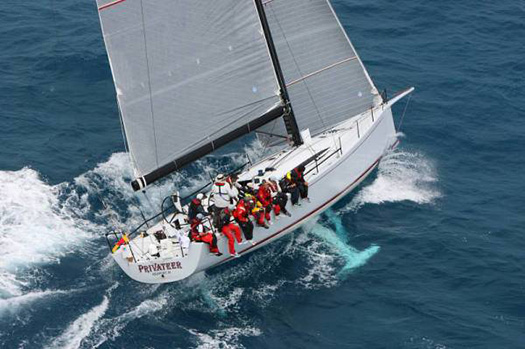
Privateer is one of the evergreen Cookson 50s, which have been consistently successful in the world's top offshore races for a decade
But as 2013's results show, doing well in the Sydney-Hobart has a huge element of horses for courses to it, and in 2010 the very new First 40 from Beneteau made a prodigious debut by taking first and second overall. They're still a very competitive boat, so not surprisingly there's five of them shaping up for the race to Hobart, and this is where the most direct Irish involvement comes, as Barry Hurley and his team have linked up with co-owner Mathew Vadas to put the beef in the crew of the First 40 Breakthrough. [Click to read Barry Hurley's preparations for this third successive Sydney–Hobart Race – Ed]
The same linkup saw Breakthrough take eighth in Class and 29th Overall in the 2013 race, but this time round Barry Hurley ships on board with the added experience of second overall and first in class in October's Middle Sea Race. With him to show that the boat is indeed sailing under the Dublin Bay Sailing Club colours are Catherine Halpin and Kenny and Alexander Rumball. And the word on the waterfront is that a shore support team not entirely unconnected with the Irish National Sailing School will be an enthusiastic presence in Sydney on December 26th. We look forward to hearing from them. Meanwhile, Happy Christmas everyone.
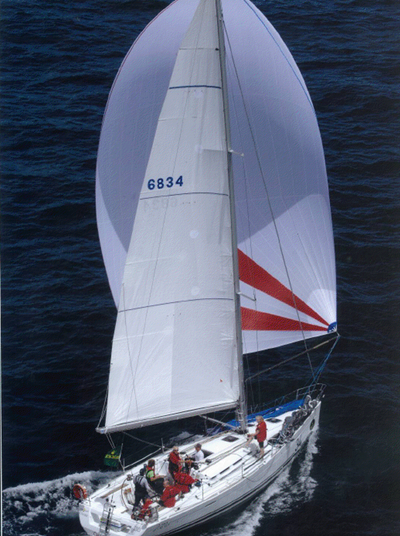
The First 40 Breakthrough will be racing under Dublin Bay Sailing Club colours in the Rolex Sydney-Hobart race 2014, starting December 26th
Velux 5 Oceans Skippers Prepare for Storm
Velux 5 Oceans skippers are battening down the hatches as a summer storm surges towards the fleet in the Southern Ocean - with giants swells and winds of more than 40 knots expected
“I’m a little anxious, I want to make sure I take care of the boat,” said sprint leader Brad Van Liew, American skipper of the Eco 60 'Le Pingoui'.
"If it doesn’t bring too much unexpected weather we could get some good fast sailing from it. If it ends up bringing a lot more wind than forecast it could be a lot more dangerous.”
Van Liew and his fellow racers have already spent three weeks at sea in the second ocean sprint, covering 5,000 nautical miles, with 2,500 left to go to the finish line in Wellington, New Zealand.
At this stage speed is of the essence, but safety is paramount - the Velux 5 Oceans skippers must make sure they they stay in the race if they want to contend for a podium finish.
As of 6pm yesterday, Le Pingouin was in the lead ahead of Zbigniew Gutkowski in Operon Racing, Derek Hatfield in Active House and Chris Stanmore-Major's Spartan.





























